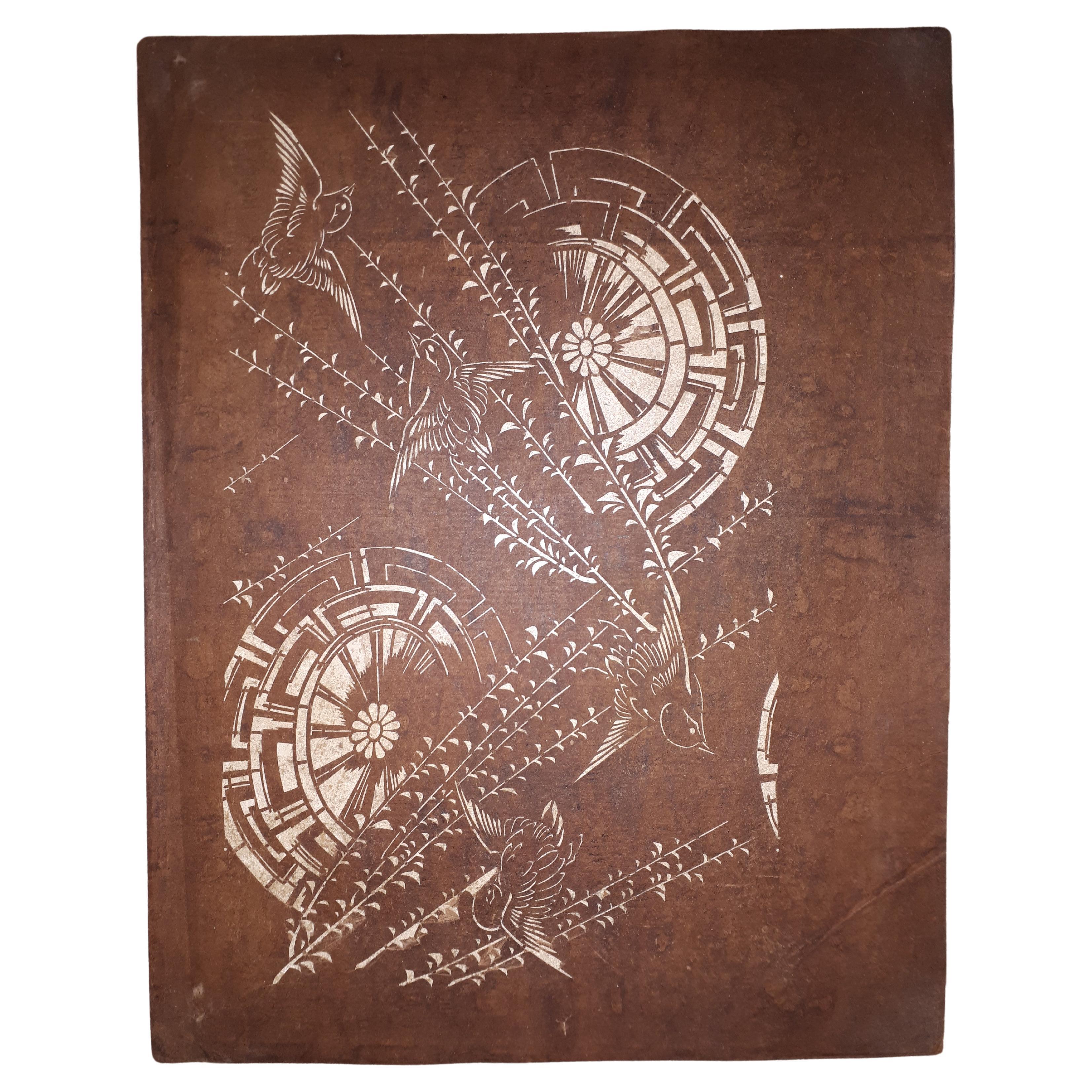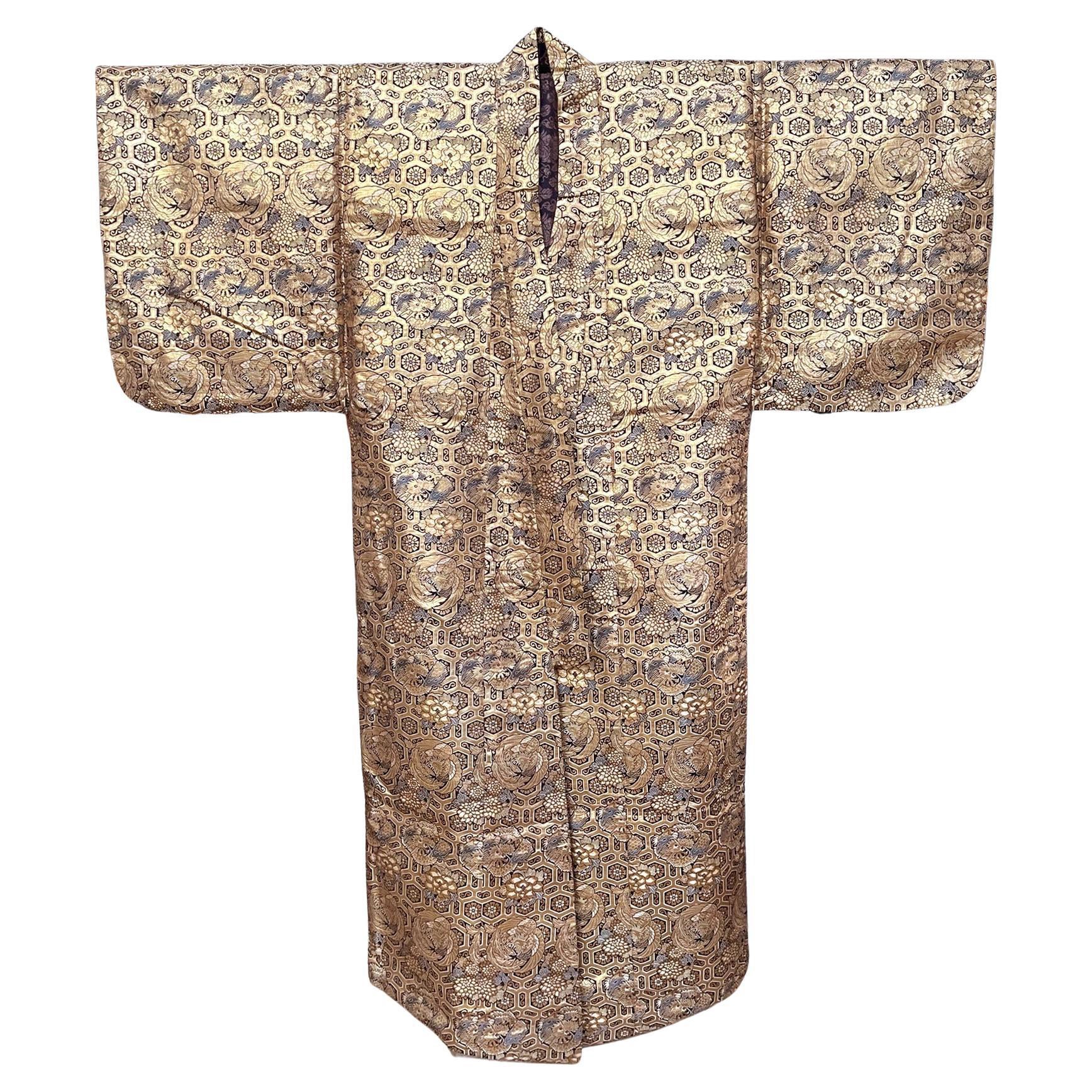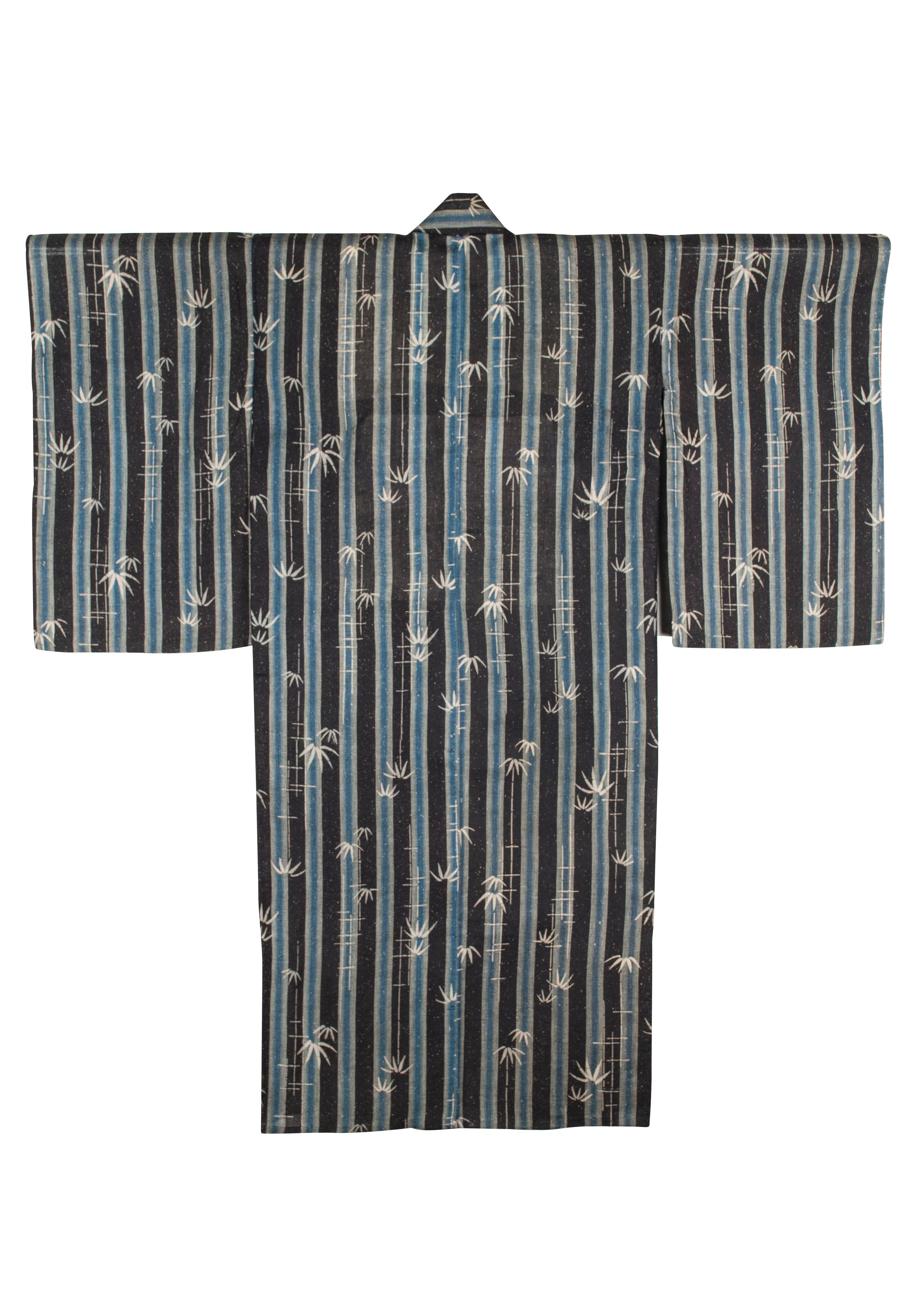Items Similar to Antique Japanese Noh Outer Cloak Chōken with Stencil Decoration
Want more images or videos?
Request additional images or videos from the seller
1 of 11
Antique Japanese Noh Outer Cloak Chōken with Stencil Decoration
About the Item
A large and striking Japanese outer cloak for Noh performance (known as Choken) circa 19th century (late Edo to early Meiji period). The robe was woven from a natural bast-fiber (known as Asa) likely fine hemp dyed in a light yellow. It was decorated with a large character with Katazome (stencil resist dye) in either dark indigo blue or a gold leaf overlay (surihaku decoration). The character is possibly the word "chi" in kanji or a Sanskrit character. Their alternate placement on the robe, both front and back, formed a geometrical pattern on its own.
As a type of Uwagi (various outer garments worn over kimono), Choken is a wide-sleeved outer cloak worn over the kimono, primarily by Noh actors performing dances in female roles. Although most were made from gauze-like silk, this robe is distinct in its material of natural fiber and a more austere decoration, which likely relates to the Noh character who worn it.
For a comparable Choken in yellow but in silk, see Accession Number: 32.30.4 in the collection of MET in NYC.
- Dimensions:Height: 49 in (124.46 cm)Width: 57 in (144.78 cm)Depth: 1 in (2.54 cm)
- Style:Edo (Of the Period)
- Materials and Techniques:
- Place of Origin:
- Period:
- Date of Manufacture:19th Century
- Condition:Wear consistent with age and use. Minor fading. Beautiful Example. Expected overall wear and patina, scattered discoloration and minor frays on the edge.
- Seller Location:Atlanta, GA
- Reference Number:1stDibs: LU945034162402
About the Seller
5.0
Platinum Seller
These expertly vetted sellers are 1stDibs' most experienced sellers and are rated highest by our customers.
Established in 2006
1stDibs seller since 2010
479 sales on 1stDibs
Typical response time: <1 hour
- ShippingRetrieving quote...Ships From: Atlanta, GA
- Return PolicyA return for this item may be initiated within 2 days of delivery.
More From This SellerView All
- Japanese Woven Linen Kimono with Katazome Stencil DyesLocated in Atlanta, GAOn offer is a Japanese summer kimono woven from indigo blue linen with ivory color fine stripes patterns with apparently darker weft additions. The elega...Category
Early 20th Century Japanese Japonisme Textiles
MaterialsLinen
- Japanese Fireman Hood with Stencil Inscription Meiji PeriodLocated in Atlanta, GAA well-preserved Japanese fireman's hood (known as hikeshi zukin in Japanese) circa 1900s, late Meiji period. Woven with thick cotton with sashiko (co...Category
Antique Early 1900s Japanese Japonisme Textiles
MaterialsCotton
- Japanese Brocade Noh Costume Kimono Robe Meiji PeriodLocated in Atlanta, GAA Noh costume made from magnificent silk twill brocade woven with metallic gold threads circa 1930s. The robe is identified as "Atsuita", made for male actors in the Noh play. The luxuriant fabric has a deep blue background with golden interlocking hexagon pattern that resembles tortoise shells, the symbol of longevity. The motifs showcase three auspicious symbols in repetitive patterns: roundels of coiled dragon, phoenix and peony. The kimono robe...Category
20th Century Japanese Meiji Textiles
MaterialsBrocade, Silk
- Antique Japanese Brocade Kesa Monk's Robe Edo PeriodLocated in Atlanta, GAA Japanese Kesa (Monk's Vestment) made from thirteen columns of patchworks of shimmering woven brocades. The elaborate motifs feature repetitive hibiscus flowers within framework of ...Category
Antique 19th Century Japanese Edo Textiles
MaterialsBrocade, Silk
- Antique Japanese Embroidered Silk Kesa Monk's Robe Edo PeriodLocated in Atlanta, GAA Japanese Kesa (Monk's Vestment) made from thirteen columns of patchworks of fine shimmering silk fabric of a salmon orange color, the shade of which changed subtly from different a...Category
Antique 19th Century Japanese Edo Textiles
MaterialsBrocade, Silk
- Antique Japanese Embroidery TapestryLocated in Atlanta, GAA large Japanese silk embroidery tapestry circa 19th century, late Edo to early Meiji period. Meticulously handwork that densely depicts repea...Category
Antique 19th Century Japanese Japonisme Textiles
MaterialsSilk
You May Also Like
- Katagami (japanese Stencil), Meiji Era JapanLocated in Saverne, Grand EstKatagami in washi paper, very finely worked. Japan, early 20th century. The sheets of paper making up Japanese stencils are made from mulberry bark. They are stuck together with fer...Category
Early 20th Century Japanese Meiji Textiles
MaterialsPaper
- Taisho-Early Showa Period Japanese Stencil-Dyed Summer Kimono with Bamboo MotifLocated in Point Richmond, CATaisho-Early Showa period Japanese Stencil-Dyed Summer Kimono with bamboo Motif A light-weight summer kimono woven of both cotton and silk, and patter...Category
Mid-20th Century Japanese Taisho Textiles
MaterialsSilk, Cotton
- Late 19th Century Japanese Stencil-Dyed Textile / Kumano-zomeLocated in Point Richmond, CALate 19th Century Japanese Stencil-Dyed Textile / Kumano-zome This 2-panel cotton textile was made in the Kumano region of Okayama Prefecture in th...Category
Antique Late 19th Century Japanese Meiji Textiles
MaterialsCotton
- "BORO" / Japanese Old Cloth / Tapestry / Wall DecorationLocated in Sammu-shi, ChibaWe have a unique Japanese sense of beauty. We will also introduce unique items that only we can make, purchasing routes in Japan, experience gained so far, and methods that no one el...Category
Early 20th Century Japanese Showa Textiles
MaterialsCotton, Linen
- "BORO" / Japanese Old Cloth / Tapestry / Wall DecorationLocated in Sammu-shi, ChibaWe have a unique Japanese sense of beauty. We will also introduce unique items that only we can make, purchasing routes in Japan, experience gained so far, and methods that no one el...Category
Early 20th Century Japanese Showa Textiles
MaterialsCotton, Linen
- Old Japanese Kimono / 1912-1945 / Wall Hanging Decoration / TapestryLocated in Sammu-shi, ChibaI think this is a kimono woven from the Taisho era to the early Showa era (1912-1945) in Japan. It is a modern design. In the Taisho era, various things were made with reference to...Category
Early 20th Century Japanese Taisho Tapestries
MaterialsCotton
Recently Viewed
View AllMore Ways To Browse
Noh Kimono
Antique Mughal Shoes
Obi Meiji
Antique Japanese Embroidered Kimono
Chinese Embroidered Silk Ladies
Frame Antique Chinese Embroidered Robe
Chinese Dragon Kimono
Antique Embroidered Rocking Chair
Flores Ikat
10 Ft Suzani
Antique Kalaga
Antique Turkmen Jewellery
Carved Jade Wall Hanging
Chinese Gold Jewelry Online Shop
Karen Sgaw
Kuba People On Sale
Pictorial Embroidered Panel Gold Thread
Rare Silk Pillows By Ferghana





